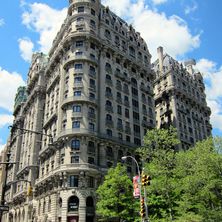

More and more modern buildings have been going up on the Upper West Side recently, especially around Lincoln Center, buildings that, with their formidable yet impersonal character, have drastically changed the look of the neighborhood. The old world feel of the Upper West Side is gradually receding into the past, unlike the Upper East Side, with 5th and Madison Avenues in particular, which have maintained their European charm and refinement.
The Ansonia is one of the last, and definitely most evident, remnants of European influence on the architecture of the Upper West Side. Located at 2109 Broadway, between 73rd and 74th Streets, it is an enormous 18-floor residential complex whose top floors, mansard roof and turrets make you feel as if you are walking down a Parisian boulevard. Originally a residential hotel, when it was constructed at the beginning of 20th century, it was the largest residential structure in the city, towering over Broadway with its haughtiness and grandeur. It takes up half of the block between Broadway and West End Avenue.
It was designed in the French Beaux-Arts style by architect Paul E. Duboy for mining magnate William Earle Dodge Stokes, who at the time was developing most of the neighborhood. Stokes was also a major shareholder in the Ansonia Clock Company, named after his grandfather Anson Greene Phelps. Therefore the name Ansonia was also given to the building. The most unconventional floor in hotel became the roof, on which Stokes created a mini-farm. It had fruit and vegetable gardens, several hundred chickens, ducks and goats, supplying the residents with fresh produce. There were even special elevators that would transport cattle up to the farm, and at one time it even had a bear.
In the beginning there were 2,500 rooms in the hotel. It was the most sensational hospitality center in Manhattan. Its luxurious apartment had views of everything from New Jersey to Brooklyn. There were libraries, restaurants, parlors, a grand ballroom, Turkish baths and seals in its lobby fountain. Its most original architectural element is the open stairwell leading up to a fascinating domed skylight.
Its notable residents throughout the years have been boxing superstar Jack Dempsey, baseball legend Babe Ruth, author Theodore Dreiser, musicians Yehudi Menuhin, Igor Stravinsky and Arturo Toscanini, opera singer Feodor Chaliapin and actresses Angelina Jolie and Natalie Portman.
In the middle of the 20th century the grand apartments were converted into studios or one-bedroom units and in the 60s the city authorities even considered demolishing the building, although eventually the artistic community living there persuaded them not to. The most likely reason is that until the late 70s the Ansonia basement was used for the Continental Baths, a popular gay bathhouse that provided first-rate entertainment for its clients. Afterwards, the basement accommodated the Plato's Retreat, New York's most famous heterosexual swinger's club, but that establishment was closed by the city in 1980.
In 1992 the Ansonia was transformed into a condominium apartment building with 425 apartments. Today it also houses half of the New York campus of the American Musical and Dramatic Academy